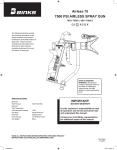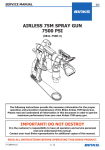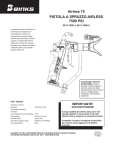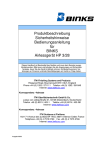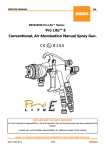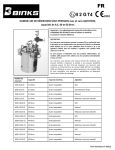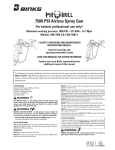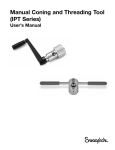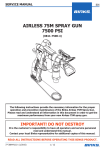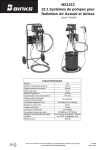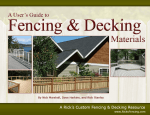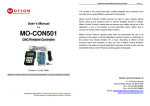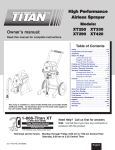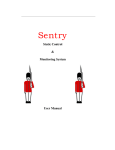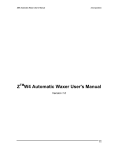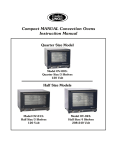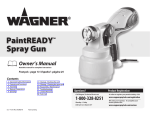Download Airless 75 7500 PSI AIRLESS SPRAY GUN
Transcript
Airless 75 7500 PSI AIRLESS SPRAY GUN 0811-7500-1, 0811-7500-2 The following instructions provide the necessary information for the proper operation and preventive maintenance of the Binks Airless 75 Spray Gun. Please read and understand all information in this document in order to get the maximum performance from your new Airless 75 spray gun. PROP 65 WARNING WARNING: This product contains chemicals known to the State of California to cause cancer and birth defects or other reproductive harm. SPECIFICATIONS: Maximum Fluid Pressure: Maximum Fluid Temperature (with heat guard installed) Gun Body: Fluid Path: 175ºF Forged Aluminum Stainless Steel Fluid Inlet Size: 1/4” NPS(m) Thread Gun Weight: 660 g IMPORTANT! DO NOT DESTROY 7500 Psi/517Bar It is the customer’s responsibility to have all operators and service personnel read and understand this manual. Contact your local Binks representative for additional copies of this manual READ ALL INSTRUCTIONS BEFORE OPERATING THIS BINKS PRODUCT INSTRUCTIONS ALSO AVAILABLE ON WWW.BINKS.COM Part Sheet 77-2950 Trigger Lock Positions NOTES 14 inches. Excessive fluid pressure will distort the spray pattern. Spray at the lowest acceptable pressure. Hour-glass and tails on spray patterns normally indicate too low a fluid pressure for the nozzle tip orifice size or the material is too viscous or thick. Increase the pressure or thin the material. Distorted patterns may be the result of worn or plugged tips. Clean (see tip clogs) or replace the spray tip. Airless spray guns are either on or off. You cannot feather with airless guns as you can with air atomized equipment. LOCKED UNLOCKED GUN OPERATION 1. Make sure your tip is in the spray position. 2. Start your sprayer following the instructions provided in the equipment owner’s manual. 3. Pull trigger to achieve flow through gun. Successive strokes may require overlapping. Typical overlap is 30%. TO REPLACE NEEDLE ASSEMBLY (11) 1. Shut off power supply to pump and release pressure from gun. Remove gun from hose. 2. Remove screws and rear cap. (15) 4. Adjust the fluid pressure on the sprayer until proper atomization is achieved. Always spray at the lowest pressure necessary to get the desired atomization. 3. Remove trigger and trigger stud (10) TIP CLOGS 4. Unscrew gland nut. If you are using a Genuine BINKS spray tip, follow the instructions below to clear a clogged tip. If you are using a different tip, follow the instructions included in the equipment manual provided with that tip. 5. Pull needle assembly out from back of gun. 7. Reinsert needle assembly (of step 5) into position through back of gun body assembly. Tighten gland nut. 1. Engage Trigger Lock. Rotate tip handle 180° to the reverse position. 8. Reassemble items. 2. Unlock trigger. Point the gun into a bucket holding the gun nose away from you. Trigger the gun briefly to expel the clog. TO REPLACE PACKING 3. Engage Trigger Lock. Rotate tip handle 180° to the spray position. 4. Unlock trigger. Spray a test to be sure the clog is completely expelled. 1. Remove needle assembly following steps 1-5 under ’To Replace Needle Assembly’. 2. Locate slot in packing gland (12), pry apart and push off. 3. Replace with new packing gland, and reassemble. NOTE: If clog is not completely expelled after following the above steps, repeat steps 1-4 until the clog is completely cleared. TO ADJUST PACKING GLAND CLEANING AND MAINTENANCE 1. Shut off power supply to pump and release pressure from gun. Remove gun from hose. CLEAN DAILY Maintaining a clean gun is important to ensure trouble-free operation and extend the service life of your gun. Always flush the gun thoroughly after each use and store in a warm, dry location. DO NOT leave the gun or any of its parts in water or solvents. Always flush gun outside if possible and at least 25 ft (7.5 m) away from sprayer. Area must be free of flammable vapors. Always flush at minimum pressure. guard. Always remove tip and Static electricity buildup may result in fire or explosion in the presence of flammable vapors. Always hold the gun firmly against a grounded, metal container when flushing. TROUBLESHOOTING Spray gun distance from work surface should be at a point where maximum fan pattern is evident. This distance is normally 8 to 2. Use 7/16’ open-end wrench to turn gland nut clockwise to eliminate any leakage at gland. 3. If sluggish trigger operation is noted, turn gland nut counterclockwise in 1/16 turn increments until drag is eliminated. 4. If leakage cannot be stopped without excessive drag on trigger, replace packing. Spraying of heated materials will require installation of the heat guard 54-7527. To install the heat guard (16): 1. Shut off power supply to pump and release pressure from gun. Remove gun from hose. 2. Remove screws and bracket (17) from bottom of the gun. Install the heat guard (16) and replace bracket and screws. 5 2 Airless 75 7500 PSI Airless Spray Gun For trained, professional use only! Maximum working pressure: 7500 PSI – 517 BAR – 51.7 Mpa Models 0811-7500-1 & 0811-7500-2 SAFETY, OPERATING AND MAINTENANCE INSTRUCTIONS INSIDE!! Read all warnings and operating information inside SAVE THIS MANUAL FOR FUTURE REFERENCE 0811-7500-2 Contact your local Binks representative for Additional copies of this manual 0811-7500-1 The following instructions provide the necessary information for other operation and preventative maintenance of the BINKS Airless 75 7500 PSI Airless Spray Gun. It is the customer’s responsibility to have all operators and service personnel read and understand this manual. Please read and understand all information in this document in order to safely operate your new spray gun. EYE HAZARD: Failure to wear safety glasses with side shields could result in serious injury or blindness. All operators and bystanders must always wear safety glasses with side shields that conform to ANSI Standard Z87.1 or European Norm 156. HAZARD: INJECTION INJURY – a high pressure stream produced by this equipment can pierce the skin and underlying tissues, leading to a serious injury and possible amputation. See a physician immediately. DO NOT TREAT AN INJECTION INJURY AS A SIMPLE CUT! Injection can lead to amputation. See a physician immediately. HAZARD: BURN HAZARD: When using the Airless 75 with a fluid heater, equipment surfaces can become very hot. ALWAYS use heat guard 54-7527 when spraying heated materials. Do not exceed 175°F fluid temperature. Do not exceed manufacturer recommended fluid temperature. SAFETY PRECAUTIONS: KEEP CLEAR OF NOZZLE: Do not exceed maximum working pressure of 7500 PSI (517 BAR, 51.7 Mpa). The maximum operating range of the gun is 7500 PSI/517 BAR fluid pressure. PREVENTION: NEVER Aim the gun at any part of the body. NEVER Allow any part of the body to touch the fluid stream. DO NOT allow body to touch a leak in the fluid hose. NEVER Put hand in front of the gun. Gloves will not provide protection against an injection injury. ALWAYS lock the gun trigger, shut the pump off, and release all pressure before servicing, cleaning the tip or guard, changing the tip, or leaving unattended. Pressure will not be released by turning off the motor. The PRIME/SPRAY valve must be turned to PRIME to relieve the pressure. Refer to the PRESSURE RELIEF PROCEDURE described in the pump manual. ALWAYS Keep the tip guard in place while spraying. The tip guard provides some protection, but is mainly a warning device. ALWAYS Remove the spray tip before flushing or cleaning the system. The paint hose can develop leaks from wear, kinking, and abuse. A leak can inject material into the skin. Inspect the hose before each use. NEVER Use a spray gun without a trigger lock and trigger guard in place and in good working order. All accessories must be rated at 7500 PSI (517 BAR) or higher. This includes spray tips, guns, extensions, and hose. NOTE TO PHYSICIAN: Injection into the skin is a traumatic injury. It is important to treat the injury as soon as possible. DO NOT DELAY treatment to research toxicity. Toxicity is a concern with some coatings injected directly into the blood stream. Consultation with a plastic surgeon or reconstructive hand surgeon may be advisable 2 3 HAZARD EXPLOSION OR FIRE – Solvent and paint fumes can explode or ignite. Severe injury and/or property damage can occur. PREVENTION: Provide extensive exhaust and fresh air introduction to keep the air within the spray area free from accumulation of flammable vapors. Avoid all ignition sources such as static electricity sparks, electrical appliances, flames, pilot lights, hot objects, and sparks from connecting and disconnecting power cords or working light switches. Do not smoke in spray area. Fire extinguisher must be present and in good working order. Place pump at least 25 feed (7.6 m) away from the spray object in a well ventilated area. Add more hose if necessary. Flammable vapors are often heavier than air. Floor area must be extremely well ventilated. The pump may contain arcing parts that emit sparks and can ignite vapors. The equipment and objects in and around the spray area must be properly grounded to prevent static sparks. Use only conductive or grounded high pressure fluid hose. Gun must be grounded through hose connections. Power cords must be connected to a grounded circuit. Always flush unit into a separate metal container, at low pump pressure, with spray tip removed. Hold gun firmly against side of container to ground container and prevent static sparks. Follow the material and solvent manufacturer’s warnings and instructions. Use extreme caution when using materials with a flashpoint below 70° F (21° C). Flashpoint is the temperature that a fluid can produce enough vapor to ignite. Plastic can cause static sparks. Never hang plastic to enclose a spray area. Do not use plastic drop cloths when spraying flammable materials. Use lowest possible pressure to flush equipment HAZARD: EXPLOSION HAZARD DUE TO INCOMPATIBLE MATERIALS – will cause severe injury or property damage. PREVENTION: Do not use materials containing bleach or chlorine. Do not use halogenated hydrocarbon solvents such as bleach, mildewcide, methylene, chloride and 1,1,1 ’ trichloroethane. They are not compatible with aluminum. Contact your coating supplier about the compatibility of material with aluminum. HAZARD: HAZARDOUS VAPORS – Paints, solvents, insecticides, and other materials can be harmful if inhaled or come in contact with the body. Vapors can cause severe nausea, fainting, or poisoning. PREVENTION: Use a respirator or mask if vapors can be inhaled. Read all instructions supplied with the mask to be sure it will provide the necessary protection. Wear protective eyewear. Wear protective clothing as required by coating manufacturer. HAZARD: GENERAL – Can cause severe injury or property damage. PREVENTION: Read all instructions and safety precautions before operating equipment. Always disconnect the motor from the power supply before working on the equipment. Follow all appropriate local, state and national codes governing ventilation, fire prevention, and operation. The United States Government Safety Standards have been adopted under the Occupational Safety and Health Act (OSHA). These standards, particularly part 1926 of the Construction Standards should be consulted. Use only manufacturer authorized parts. User assumes all risks and liabilities when using parts that do not meet the minimum specifications and safety devices of the pump manufacturer. Before each use, check all hoses for cuts, leaks, abrasion, or bulging of cover. Check for damage or movement of couplings. Immediately replace the hose if any of these conditions exist. Never repair a paint hose. Replace it with another grounded high-pressure hose. All hoses, swivels, guns, and accessories must be pressure rated at or above the maximum operating pressure range of the airless sprayer. Do not spray outdoors on windy days. Wear protective clothing to keep paint off skin and hair. The following are general WARNINGS related to the setup, use, grounding, maintenance and repair of this equipment. FIRE AND EXPLOSION HAZARD – Flammable fumes, such as solvents and paint fumes, in work area can ignite or explode. To help prevent fire and explosion: Use equipment only in well ventilated area. Provide fresh air ventilation to avoid the buildup of flammable fumes from the material being sprayed or from the solvent. Eliminate all ignition sources; such as pilot lights, cigarettes, portable electric lamps, and plastic drop cloths (potential static arc). Keep work area free of debris; including solvent, rags, and gasoline. Sprayers generate sparks. When flammable liquid is used in or near sprayer or for flushing or cleaning, keep sprayer at least 25 feet (7.6m) away from explosive vapors. Electrically disconnect all equipment in the spray area. Do not plug or unplug power cords or turn lights on or off when flammable fumes are present. Ground equipment and conductive objects in work area. Ground object being sprayed. If there is static sparking or you feel a shock, stop operating immediately. Do not use equipment until you identity and correct the problem. Keep a fire extinguisher in the work area. SKIN INJECTION HAZARD High pressure fluid from spray gun, hose leaks, or ruptured components will pierce skin. This may look like just a cut, but is a serious injury that can cause amputation. Seek immediate surgical treatment. Inform the physician as to what type of material was injected. Do not point gun at anyone or any part of the body. Do not put your hand or fingers over the spray tip. Do not stop or deflect leaks with your hand, body, glove or rag. Do not spray without tip guard installed. Engage trigger lock when not spraying. 3 4 Follow pressure relief procedure for your sprayer when you stop spraying and before cleaning, checking or servicing your equipment. SET UP INSTALLATION Tighten all fluid connections before operating equipment. Never attempt to assemble, change, or clean the gun, tip, or tip guard without first relieving pressure from the spray system. Follow the “PRESSURE RELIEF PROCEDURE” in the sprayer’s equipment manual. Check all hoses, tubes, and couplings daily. Replace all worn, damaged, or loose parts immediately. EQUIPMENT MISUSE HAZARD This equipment is for professional use only. Read and understand all instructional manuals, tags, and labels before operating equipment. Use equipment only for its intended purpose. If you are unsure of its purpose, call your local BINKS distributor. Misuse can cause death or serious injury. Do not exceed the maximum working pressure or temperature rating of the lowest rated system component. See the technical data in all equipment manuals. Use fluids and solvents that are compatible with your equipment wetted parts. See technical data in all equipment manuals. Read fluid and solvent manufacturer’s warnings. For complete information about your material, request a MSDS from your distributor or retailer. Check your equipment daily. Do not alter or modify your equipment. Repair or replace worn or damaged parts immediately with genuine BINKS Replacement Parts only. Always use tip safety guard for added protection against injection. Beware that the guard alone will not prevent injection. NEVER cut off tip guard! Always engage gun trigger lock when the gun is not in use. Before servicing equipment, consult all equipment manuals and follow all warnings. Do not allow fluid to exceed the fluid manufactures recommended maximum temperature. Gun must include heat guard (54-7527) to be used with heated materials. Note: BINKS Airless Spray Gun Safety Tip Guards for the 7500 PSI (517 BAR) gun are gray in color. BINKS Airless 75 PROFESSIONAL AIRLESS SPRAY GUN 7500 PSI (517 BAR) MODEL 0811-7500-1 AND 0811-7500-2 Do not alter or modify this equipment. Use equipment only for its intended purpose. Call Binks for more information. Safety Guard Route hoses and cables away from traffic areas, sharp edges, moving parts and hot surfaces. Do not kink or over bend hoses or use hoses to pull equpment. Use genuine BINKS hoses. If provided, do not remove the spring guards from hoses, these are on the hoses to prevent rupture from kinking at the connectors. Trigger Lock Trigger Keep children and animals away from work area. Comply with all applicable safety regulations. Do not operate equipment when fatigued or under the influence of drugs or alcohol. TOXIC FLUID HAZARD Know the specific hazards of the fluid you are using. This information is on the MSDS for the material that is being used. Read all fluid manufacturer’s warnings. Store hazardous fluids in approved containers only. Dispose of all hazardous fluids in accordance with all state, local and national guidelines. Wear the appropriate protective clothing, gloves, eyewear and respirator. GROUNDING AND ELECTRIC REQUIREMENTS The sprayer and gun must be grounded. Grounding reduces the risk of static and electric shock by providing an escape wire for the electrical current due to static build up or in the event of a short circuit. Follow the grounding instructions included in the equipment manual provided with all your spray equipment. Additional grounding instructions for your BINKS Airless 75 Spray Gun are provided: Ground your BINKS Airless 75 Spray Gun through connection to a properly grounded fluid hose and pump. 1/4 - 18 NPS thread If you are using a genuine BINKS tip, follow the instructions below to install the guard and tip. If you are using a different tip, follow the installation instructions provided with the tip that you are using. INSTALLATION OF THE TIP AND GUARD 1. Make sure that the tip and tip guard are rated for use at 7500 PSI. (Genuine BINKS parts will be gray in color.) 2. Use seal alignment tool on BINKS tip handle to insert seal and pressure gasket into back of guard, turn to align with tip shaft opening. 3. Insert tip into opening on BINKS guard. NOTE: Narrow end of tip handle should be in forward position for spraying. 4. Thread the guard onto gun head until it stops. Tighten slightly with wrench ’ DO NOT OVER TIGHTEN. CONNECTION TO THE HOSE Attach a properly grounded fluid hose to the fluid hose connection fitting (1/4 ’ 18 NPS thread) on the bottom of the handle of your spray gun. Use two (2) wrenches ’ one on the gun and one on the hose. Tighten securely. 4 5 Trigger Lock Positions 14 inches. Excessive fluid pressure will distort the spray pattern. Spray at the lowest acceptable pressure. Hour-glass and tails on spray patterns normally indicate too low a fluid pressure for the nozzle tip orifice size or the material is too viscous or thick. Increase the pressure or thin the material. Distorted patterns may be the result of worn or plugged tips. Clean (see tip clogs) or replace the spray tip. Airless spray guns are either on or off. You cannot feather with airless guns as you can with air atomized equipment. LOCKED UNLOCKED GUN OPERATION 1. Make sure your tip is in the spray position. 2. Start your sprayer following the instructions provided in the equipment owner’s manual. 3. Pull trigger to achieve flow through gun. Successive strokes may require overlapping. Typical overlap is 30%. TO REPLACE NEEDLE ASSEMBLY (11) 1. Shut off power supply to pump and release pressure from gun. Remove gun from hose. 2. Remove screws and rear cap. (15) 4. Adjust the fluid pressure on the sprayer until proper atomization is achieved. Always spray at the lowest pressure necessary to get the desired atomization. 3. Remove trigger and trigger stud (10) TIP CLOGS 4. Unscrew gland nut. If you are using a Genuine BINKS spray tip, follow the instructions below to clear a clogged tip. If you are using a different tip, follow the instructions included in the equipment manual provided with that tip. 5. Pull needle assembly out from back of gun. 7. Reinsert needle assembly (of step 5) into position through back of gun body assembly. Tighten gland nut. 1. Engage Trigger Lock. Rotate tip handle 180° to the reverse position. 8. Reassemble items. 2. Unlock trigger. Point the gun into a bucket holding the gun nose away from you. Trigger the gun briefly to expel the clog. TO REPLACE PACKING 3. Engage Trigger Lock. Rotate tip handle 180° to the spray position. 4. Unlock trigger. Spray a test to be sure the clog is completely expelled. 1. Remove needle assembly following steps 1-5 under ’To Replace Needle Assembly’. 2. Locate slot in packing gland (12), pry apart and push off. 3. Replace with new packing gland, and reassemble. NOTE: If clog is not completely expelled after following the above steps, repeat steps 1-4 until the clog is completely cleared. TO ADJUST PACKING GLAND CLEANING AND MAINTENANCE 1. Shut off power supply to pump and release pressure from gun. Remove gun from hose. CLEAN DAILY Maintaining a clean gun is important to ensure trouble-free operation and extend the service life of your gun. Always flush the gun thoroughly after each use and store in a warm, dry location. DO NOT leave the gun or any of its parts in water or solvents. Always flush gun outside if possible and at least 25 ft (7.5 m) away from sprayer. Area must be free of flammable vapors. Always flush at minimum pressure. guard. Always remove tip and Static electricity buildup may result in fire or explosion in the presence of flammable vapors. Always hold the gun firmly against a grounded, metal container when flushing. TROUBLESHOOTING Spray gun distance from work surface should be at a point where maximum fan pattern is evident. This distance is normally 8 to 2. Use 7/16’ open-end wrench to turn gland nut clockwise to eliminate any leakage at gland. 3. If sluggish trigger operation is noted, turn gland nut counterclockwise in 1/16 turn increments until drag is eliminated. 4. If leakage cannot be stopped without excessive drag on trigger, replace packing. Spraying of heated materials will require installation of the heat guard 54-7527. To install the heat guard (16): 1. Shut off power supply to pump and release pressure from gun. Remove gun from hose. 2. Remove screws and bracket (17) from bottom of the gun. Install the heat guard (16) and replace bracket and screws. 5 6 Item No. 1 2 3 4 5 6 7 9 10 11 12 14 15 16 17 18 Part No. 1108-75B 54-7511-K 54-2096-K5 54-7518-K 54-7523-K 72-792 20-5865-K3 54-7534-K 54-7512 54-2949 54-7508 54-7530-K 54-7527 54-7510-K 54-7519-K Description Twist Tip 7500 psi, see chart 7500 psi Twist Tip Guard Diffuser Nut Kit Washer (Kit of 5) Fluid Tube Assembly kit Gun Head Kit Inlet Adapter Set Screw (Kit of 3) Trigger Kit Needle Assembly Packing Gland Spring Rear Cap Kit Heat Guard (Accessory) Bracket Kit Hose Retainer Quantity 1 1 1 1 1 1 1 1 1 1 1 1 1 1 1 0811-7500-1 only. 0811-7500-2 only. 6 7 BINKS BINKS SPRAY TIP SELECTION CHART PART NUMBER 9-XXX-75 (Tips rated for use at 7500 psi) All of the following tips will have a grey tip handle 4” spray pattern .007" orifice .009" orifice .011" orifice .013" orifice .015" orifice .017" orifice .019" orifice .021" orifice .023" orifice .025" orifice .027" orifice .031" orifice .035" orifice 211 213 215 217 6” spray pattern 307 309 311 313 315 317 8” spray pattern 10” spray pattern 409 411 413 415 417 419 421 509 511 513 515 517 519 521 523 525 12” spray pattern 435 611 613 615 617 619 621 623 625 627 631 635 14” spray pattern 713 715 717 ORDER NUMBER 72-2332 72-2333 72-2340 72-2341 54-1836 54-1835 52-5208 52-5209 72-2339 ACCESSORIES DESCRIPTION Swivel Adapter 1/4” M x 1/4” F Swivel Adapter 3/8” M x 1/4” F Swivel Adapter with inlet filter (60 Mesh) Swivel Adapter with inlet filter (100 Mesh) 60 Mesh filter 100 Mesh filter 30” Airless Tip Extension 60” Airless Tip Extension High Pressure “Y” Block (7,250 psi max) BINKS ORDER NUMBER 71-4870 71-4840 71-4841 71-4860 71-4861 AIR HOSE DESCRIPTION Hose Whip 1/4” F x 3/8” M 3 ft, 10,000 psi working pressure Hose 1/4” x 25 ft 10,000 psi working pressure Hose 1/4” x 50 ft 10,000 psi working pressure Hose 3/8” x 25 ft 8,000 psi working pressure Hose 3/8” x 50 ft 8,000 psi working pressure The Spray Gun models listed in the following declaration of conformity may be used in some potentially explosive atmospheres ONLY when the special conditions for safe installation and operation have been followed as expressed in this user manual (Part Sheet). These models are approved to ATEX regulations 94/9/EC, protection level: II 2 G X: Suitable for use in Zones 1 and 2. EC Declaration of Conformity Manuf. By:Binks 195 Internationale Blvd. Glendale Heights, IL 60139 Type/Series: Handheld Spray Guns Model: 0811-7500-1, 0811-7500-2 The equipment to which this document relates is in conformance with the following standards or other normative references: EN ISO 12100-1&2:2003 and BS EN 1953:1999 and thereby conform to the protection requirements of Council Directive 2006/42/EC relating to Machinery Safety Directive, and; EN 13463-1:2001, Council Directive 94/9/EC relating to Equipment and Protective Systems for use in Potentially Explosive Atmospheres, protection level II 2 G X. Approved By: _______________ Date: 12/1/2011 Doug Taylor, Binks WARRANTY This product is covered by Binks’ 1 Year Limited Warranty. Binks Worldwide Sales and Service Listing: www.binks.com North American Office Binks 195 Internationale Blvd. Glendale Heights, IL 60139 630-237-5000 www.binks.com Toll Free Customer Service and Technical Support 800-992-4657 Toll Free Fax 888-246-5732 1/12 © 2012 Binks All rights reserved. Binks European Sales and Service Listing: www.itwifeuro.com ITW Industrial Finishing Binks has authorized distributors throughout the world. For technical assistance or the distributor nearest you, see listing below. ITW Industrial Finishing: Ringwood Road, Bournemouth BH11 9LH England Tel: +44(0) 1202 571111 Fax: +44(0) 1202 573488 Email: [email protected] ITW Surfaces et Finitions: 163-171 Av des Auréals 26014 Valence cedex France Tel: +33 4 75 75 27 00 Fax: +33 4 75 75 27 59 Email: [email protected] ITW Oberflächentechnik GmbH: Justus-von-Liebig-Straße 31 D-63128 Dietzenbach Germany Tel: +49 (0) 6074-403-1 Fax: +49 (0) 6074-403-300 Email: [email protected] 1/12 © 2012 ITW Industrial Finishing All rights reserved. Printed in Mexico.








